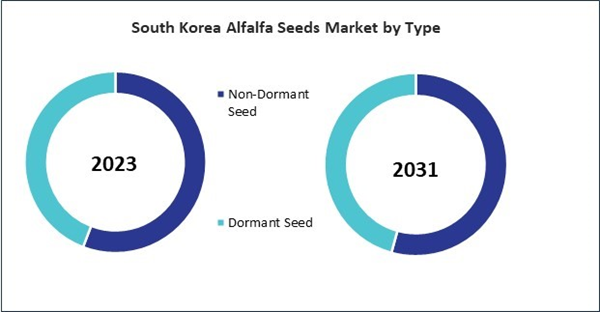Within agriculture, alfalfa seeds find widespread usage in various applications, including forage production, animal feed, and soil improvement. As a highly nutritious forage crop, alfalfa is extensively grown for livestock feed, providing essential proteins, vitamins, and minerals to dairy cows, beef cattle, and other grazing animals. Therefore, the agriculture sector of India market used 450.99 Tonnes of alfalfa seeds in the market in 2023.
The China market dominated the Asia Pacific Alfalfa Seeds Market by Country in 2023 and would continue to be a dominant market till 2031; thereby, achieving a market value of $48.3 Million by 2031. The Japan market is registering a CAGR of 6.7% during (2024 - 2031). Additionally, The India market would showcase a CAGR of 8.1% during (2024 - 2031).
Alfalfa seeds are cultivated for forage production, serving as a valuable source of livestock feed and a means of generating income for farmers. Alfalfa hay is prized for its high protein content, palatability, and digestibility, making it a preferred feed option for dairy cows and other ruminant animals. Alfalfa can be harvested multiple times throughout the growing season, providing a continuous source of nutritious forage for livestock.
Moreover, alfalfa seeds are also grown for seed production, supplying the market with high-quality alfalfa seeds for planting new alfalfa fields or for use in seed blends for pastures and forage crops. Seed producers employ advanced breeding techniques, seed treatment methods, and quality assurance measures to ensure the production of viable and genetically pure alfalfa seeds. Adopting alfalfa seeds varies across regions and is influenced by various factors, including agricultural practices, climate conditions, market demand, and policy frameworks.
With the expansion of the animal feed industry in India, there is a rising demand for high-quality forage crops to meet the dietary needs of livestock. Alfalfa, known for its high protein content and nutritional value, is a preferred feed ingredient for dairy cows, beef cattle, and other livestock. The increasing demand for nutritious feed could boost the demand for alfalfa seeds in India. Therefore, the increasing animal feed industry and rising agriculture sector in the region propel the market’s growth.
Based on Type, the market is segmented into Non-Dormant Seed, and Dormant Seed. Based on Application, the market is segmented into Agriculture, Health Food, and Others. Based on countries, the market is segmented into China, Japan, India, South Korea, Australia, Malaysia, and Rest of Asia Pacific.
List of Key Companies Profiled
- Allied Seed, LLC
- Bayer AG
- S&W Seed Company
- Royal Barenbrug Group
- Nutrien Ltd. (Dyna-Gro Seed)
- Great Basin Seed
- DLF Seeds A/S
- Forage Genetics International, LLC
- The Dow Chemical Company
- Syngenta Crop Protection AG
Market Report Segmentation
By Type (Volume, Tonnes, USD Million, 2020-31)- Non-Dormant Seed
- Dormant Seed
- Agriculture
- Health Food
- Others
- China
- Japan
- India
- South Korea
- Australia
- Malaysia
- Rest of Asia Pacific
Table of Contents
Companies Mentioned
- Allied Seed, LLC
- Bayer AG
- S&W Seed Company
- Royal Barenbrug Group
- Nutrien Ltd. (Dyna-Gro Seed)
- Great Basin Seed
- DLF Seeds A/S
- Forage Genetics International, LLC
- The Dow Chemical Company
- Syngenta Crop Protection AG









